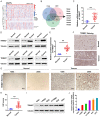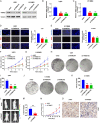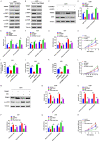TRIM27 promotes the Warburg effect and glioblastoma progression via inhibiting the LKB1/AMPK/mTOR axis
- PMID: 39113875
- PMCID: PMC11301283
- DOI: 10.62347/TKFV8564
TRIM27 promotes the Warburg effect and glioblastoma progression via inhibiting the LKB1/AMPK/mTOR axis
Abstract
Altered protein ubiquitination is associated with cancer. The novel tripartite motif (TRIM) family of E3 ubiquitin ligases have been reported to play crucial roles in the development, growth, and metastasis of various tumors. The TRIM family member TRIM27 acts as a potential promoter of tumor development in a wide range of cancers. However, little is known regarding the biological features and clinical relevance of TRIM27 in glioblastoma (GBM). Here, we report findings of elevated TRIM27 expression in GBM tissues and GBM cell lines. Further functional analysis showed that TRIM27 deletion inhibited GBM cell growth both in vitro and in vivo. Furthermore, we found that TRIM27 promoted the growth of GBM cells by enhancing the Warburg effect. Additionally, the inactivation of the LKB1/AMPK/mTOR pathway was critical for the oncogenic effects of TRIM27 in GBM. Mechanistically, TRIM27 could directly bind to LKB1 and promote the ubiquitination and degradation of LKB1, which in turn enhanced the Warburg effect and GBM progression. Collectively, these data suggest that TRIM27 contributes to GNM pathogenesis by inhibiting the LKB1/AMPK/mTOR axis and may be a promising candidate as a potential diagnostic and therapeutic marker for patients with GBM.
Keywords: AMPK; Glioblastoma; LKB1; TRIM27; Warburg effect.
AJCR Copyright © 2024.
Conflict of interest statement
None.
Figures






Similar articles
-
TRIM27 interacts with Iκbα to promote the growth of human renal cancer cells through regulating the NF-κB pathway.BMC Cancer. 2021 Jul 20;21(1):841. doi: 10.1186/s12885-021-08562-5. BMC Cancer. 2021. PMID: 34284744 Free PMC article.
-
MAGED4B Promotes Glioma Progression via Inactivation of the TNF-α-induced Apoptotic Pathway by Down-regulating TRIM27 Expression.Neurosci Bull. 2023 Feb;39(2):273-291. doi: 10.1007/s12264-022-00926-6. Epub 2022 Aug 20. Neurosci Bull. 2023. PMID: 35986882 Free PMC article.
-
TRIM25 promotes glioblastoma cell growth and invasion via regulation of the PRMT1/c-MYC pathway by targeting the splicing factor NONO.J Exp Clin Cancer Res. 2024 Feb 2;43(1):39. doi: 10.1186/s13046-024-02964-6. J Exp Clin Cancer Res. 2024. PMID: 38303029 Free PMC article.
-
Role of the tripartite motif protein 27 in cancer development.J Natl Cancer Inst. 2012 Jun 20;104(12):941-52. doi: 10.1093/jnci/djs224. Epub 2012 May 3. J Natl Cancer Inst. 2012. PMID: 22556269
-
Emerging roles of TRIM27 in cancer and other human diseases.Front Cell Dev Biol. 2022 Sep 19;10:1004429. doi: 10.3389/fcell.2022.1004429. eCollection 2022. Front Cell Dev Biol. 2022. PMID: 36200036 Free PMC article. Review.
Cited by
-
Unveiling the multifaceted functions of TRIM proteins in glioma pathogenesis.Transl Oncol. 2025 Aug;58:102419. doi: 10.1016/j.tranon.2025.102419. Epub 2025 May 26. Transl Oncol. 2025. PMID: 40424933 Free PMC article. Review.
-
Multifaceted role of TRIM28 in health and disease.MedComm (2020). 2024 Nov 11;5(11):e790. doi: 10.1002/mco2.790. eCollection 2024 Nov. MedComm (2020). 2024. PMID: 39534556 Free PMC article. Review.
-
Fructose 1,6-bisphosphatase 1 is a potential biomarker affecting the malignant phenotype and aerobic glycolysis in glioblastoma.PeerJ. 2025 Jan 31;13:e18926. doi: 10.7717/peerj.18926. eCollection 2025. PeerJ. 2025. PMID: 39902328 Free PMC article.
-
Decoding the epigenetic-immune nexus in hepatocellular carcinoma: a Mendelian randomization study reveals BTN3A2, S100A12 and TRIM27 as white blood cell regulators.BMC Cancer. 2025 Aug 8;25(1):1282. doi: 10.1186/s12885-025-14693-w. BMC Cancer. 2025. PMID: 40775620 Free PMC article.
References
-
- Ma R, Taphoorn MJB, Plaha P. Advances in the management of glioblastoma. J Neurol Neurosurg Psychiatry. 2021;92:1103–1111. - PubMed
-
- Campos B, Olsen LR, Urup T, Poulsen HS. A comprehensive profile of recurrent glioblastoma. Oncogene. 2016;35:5819–5825. - PubMed
-
- Le Rhun E, Preusser M, Roth P, Reardon DA, van den Bent M, Wen P, Reifenberger G, Weller M. Molecular targeted therapy of glioblastoma. Cancer Treat Rev. 2019;80:101896. - PubMed
-
- Popovic D, Vucic D, Dikic I. Ubiquitination in disease pathogenesis and treatment. Nat Med. 2014;20:1242–1253. - PubMed
LinkOut - more resources
Full Text Sources
Miscellaneous
